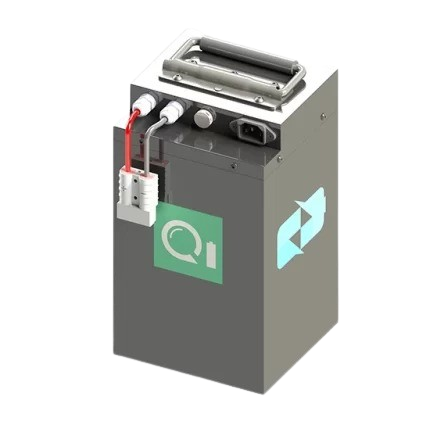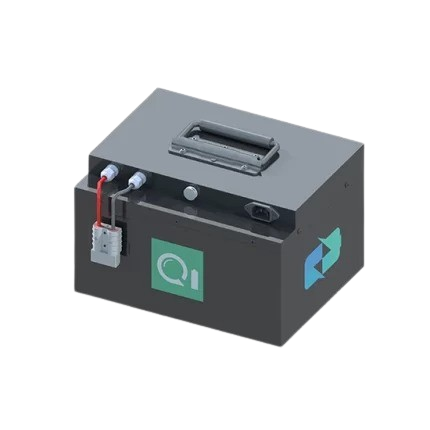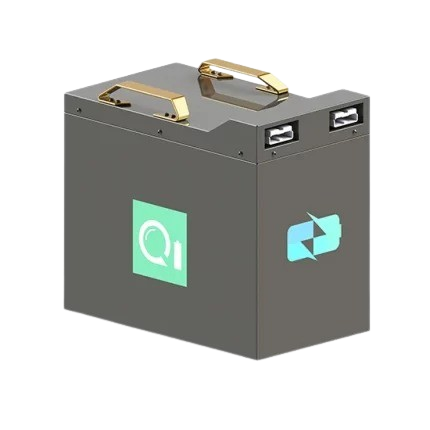


2 Wheeler Battery Packs
Qmax has designed and developed a range of standard battery packs which are most commonly used by our customers and available off the shelf. We do a detailed analysis after understanding the customer's requirement to offer the right chemistry, from factor and cooling techniques for our battery packs. The specific design and specifications of a two-wheeler battery pack can vary depending on the manufacturer, model, and intended use of the vehicle. Here are some key points to consider regarding two wheeler battery packs:
Voltage
Two-wheeler battery packs generally operate at a specific voltage, such as 48V, 60V, or 72V. The voltage requirement depends on the power requirements of the electric motor and other electrical components on the vehicle. It is very important to match the operating voltages of the battery pack and the vehicle.
Capacity
The capacity of a two-wheeler battery pack is typically measured in ampere-hours (Ah) and represents the amount of charge the battery can store. Higher capacity batteries can provide longer riding range but may also
be physically larger and heavier.
Battery Chemistry
Nickel Manganese Cobalt (NMC) batteries are most commonly used in two wheeler battery packs due to their high energy density, lightweight nature, and long cycle life. Other battery chemistries, such as Lithium Iron Phosphate (LFP), may also be used in some cases where space or weight is not a major constraint.Qmax also makes packs with (Lithium Manganese Iron Phosphate) LMFP which is 20% higher in energy density compared to LFP chemistry, but within the same dimensions and weight.
Battery Management System (BMS)
A BMS is an essential component of a two-wheeler battery pack. It monitors and manages the charging and discharging of individual cells, helps maintain optimal performance, and ensures safety by preventing overcharging, over discharging, and overheating. At Qmax Ion, we ensure the highest reliability of the BMS used as this is a no-compromise component of the battery pack.
Charging
Two-wheeler battery packs can be charged using standard electrical outlets or specialized charging stations. Charging times can vary depending on the battery capacity and the charging infrastructure available. Qmax Ion’s battery packs can be fast charged in 20 mins upto 80% of SOC. Qmax also makes packs with (Lithium Manganese Iron Phosphate) LMFP which is 20% higher in energy density compared to LFP chemistry, but within the same dimensions and weight.
Swappable Battery Systems
Some electric two-wheeler OEMs employ swappable battery systems, allowing users to quickly exchange depleted batteries for fully charged ones. This approach reduces charging times and provides flexibility for riders. Qmax Ion batteries can be designed to be compatible with bulk chargers.At Qmax Ion, we ensure the highest reliability of the BMS used as this is a no compromise component of the battery pack.be physically larger and heavier.
Why Qmax 2 Wheeler Batteries are preferred by customers
Long Life
Compact
AIS 156 Compliance
| Battery Pack | 30Ah (Nominal) |
|---|---|
| Rated Energy (0.2C, 100% DoD at 25°C) | 1.44 kWh (48 V) / 1.82 kWh (60 V) |
| Estimated Life (at 80% DoD 35°C) | 1000 Cycles (70% capacity Retention at EOL) |
| Nominal Voltage | 48 / 60.8 V |
| Charge Current | 15 A (Nominal) |
| Discharge Current | 15 A (Nominal) / 30 A (Max) |
| Peak Discharge Current | 60 A (for 10 sec) --- (To be configurable as per duty cycle) |
| Operating Temperature | 0°C to 50°C Charge and -10°C to 60°C discharge |
| Battery Pack | 36Ah (Nominal) |
|---|---|
| Rated Energy (0.2C, 100% DoD at 25°C) | 1.73 kWh (48 V) / 2.19 kWh (60 V) |
| Estimated Life (at 80% DoD 35°C) | 1000 Cycles (70% capacity Retention at EOL) |
| Nominal Voltage | 48 / 60.8 V |
| Charge Current | 18 A (Nominal) |
| Discharge Current | 18 A (Nominal) / 36 A (Max) |
| Peak Discharge Current | 72 A (for 10 sec) --- (To be configurable as per duty cycle) |
| Operating Temperature | 0°C to 50°C Charge and -10°C to 60°C discharge |
| Battery Pack | 45Ah(Nominal) |
|---|---|
| Rated Energy (0.2C, 100% DoD at 25°C) | 3.31 kWh (72 V) |
| Estimated Life (at 80% DoD 35°C) | 1000 Cycles (70% capacity Retention at EOL) |
| Nominal Voltage | 73.6 (72 V) |
| Charge Current | 22.5 A (Nominal) |
| Discharge Current | 22.5 A (Nominal) / 45 A (Max) |
| Peak Discharge Current | 90 A (for 10 sec) --- (To be configurable as per duty cycle) |
| Operating Temperature | 0°C to 50°C Charge and -10°C to 60°C discharge |
| Battery Pack | 26Ah (Nominal) |
|---|---|
| Rated Energy (0.2C, 100% DoD at 25°C) | 1.3 kWh (48 V) / 1.5 kWh (60 V) |
| Estimated Life (at 80% DoD 35°C) | 1000 Cycles (70% capacity Retention at EOL) |
| Nominal Voltage | 50.4 (48) / 57.6 (60) V |
| Charge Current | 13 A (Nominal) |
| Discharge Current | 13 A (Nominal) / 26 A (Max) |
| Peak Discharge Current | 52 A (for 10 sec) --- (To be configurable as per duty cycle) |
| Operating Temperature | 0°C to 50°C Charge and -10°C to 60°C discharge |
| Battery Pack | 36Ah (Nominal) |
|---|---|
| Rated Energy (0.2C, 100% DoD at 25°C) | 1.81 kWh (48 V) / 2.07 kWh (60 V) |
| Estimated Life (at 80% DoD 35°C) | 1000 Cycles (70% capacity Retention at EOL) |
| Nominal Voltage | 50.4 (48) / 57.6 (60) Vdc |
| Charge Current | 18 A (Nominal) |
| Discharge Current | 18 A (Nominal) / 36 A (Max) |
| Peak Discharge Current | 72 A (for 10 sec) --- (To be configurable as per duty cycle) |
| Operating Temperature | 0°C to 50°C Charge and -10°C to 60°C discharge |
| Battery Pack | 45Ah (Nominal) |
|---|---|
| Rated Energy (0.2C, 100% DoD at 25°C) | 3.24 kWh (72 V) |
| Estimated Life (at 80% DoD 35°C) | 1000 Cycles (70% capacity Retention at EOL) |
| Nominal Voltage | 72 V |
| Charge Current | 22.5 A (Nominal) |
| Discharge Current | 22.5 A (Nominal) / 45 A (Max) |
| Peak Discharge Current | 90 A (for 10 sec) --- (To be configurable as per duty cycle) |
| Operating Temperature | 0°C to 50°C Charge and -10°C to 60°C discharge |
